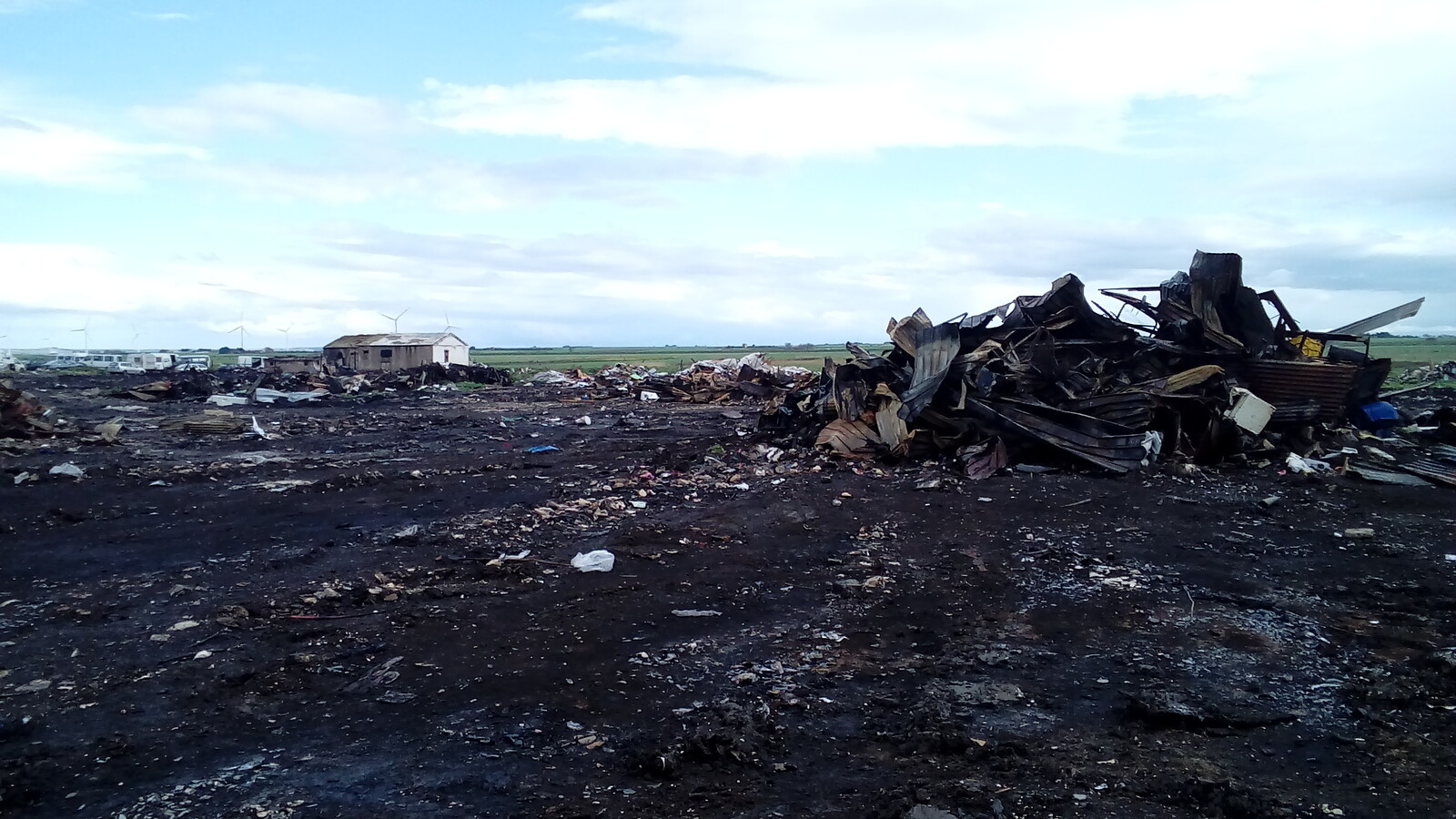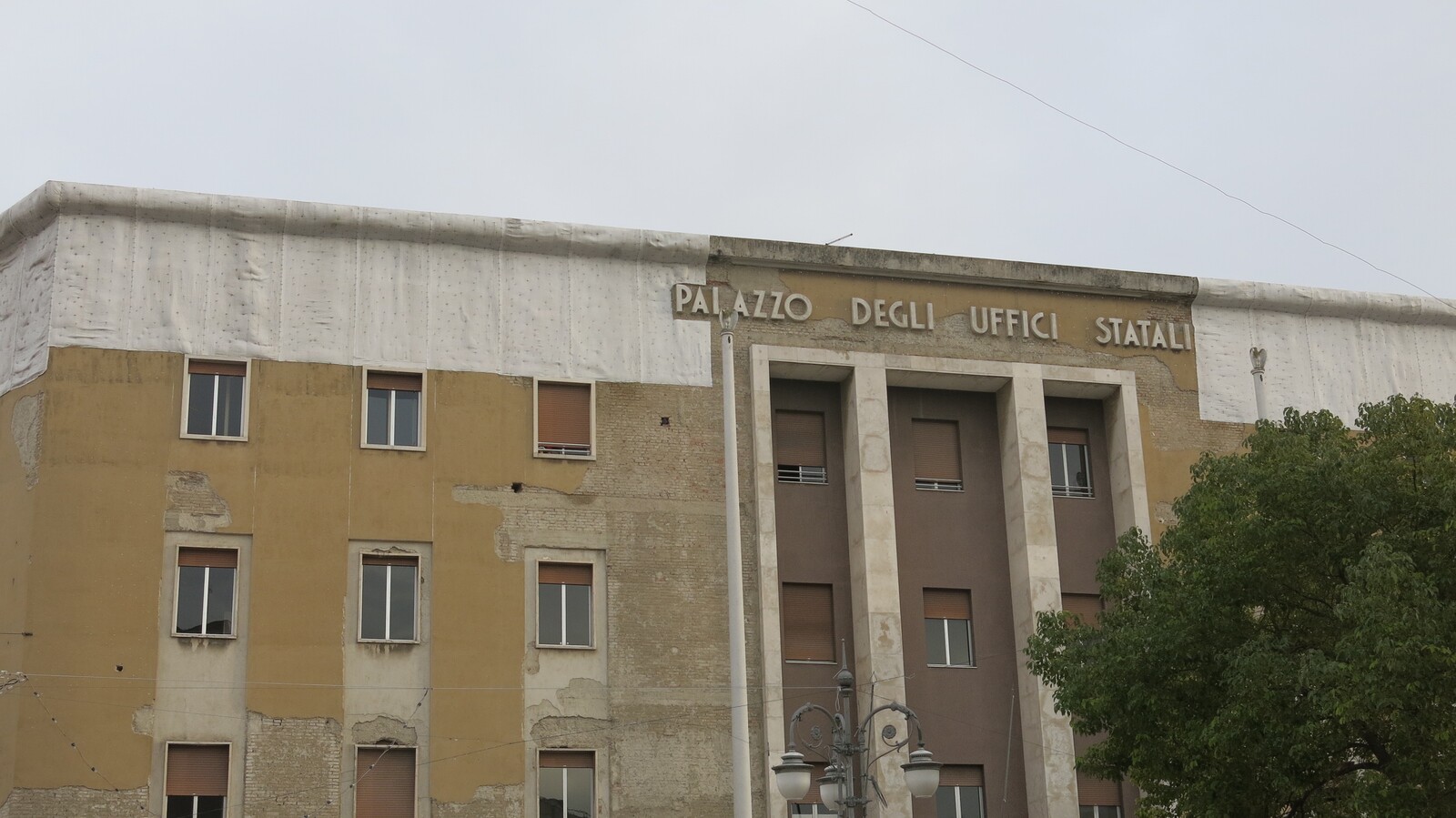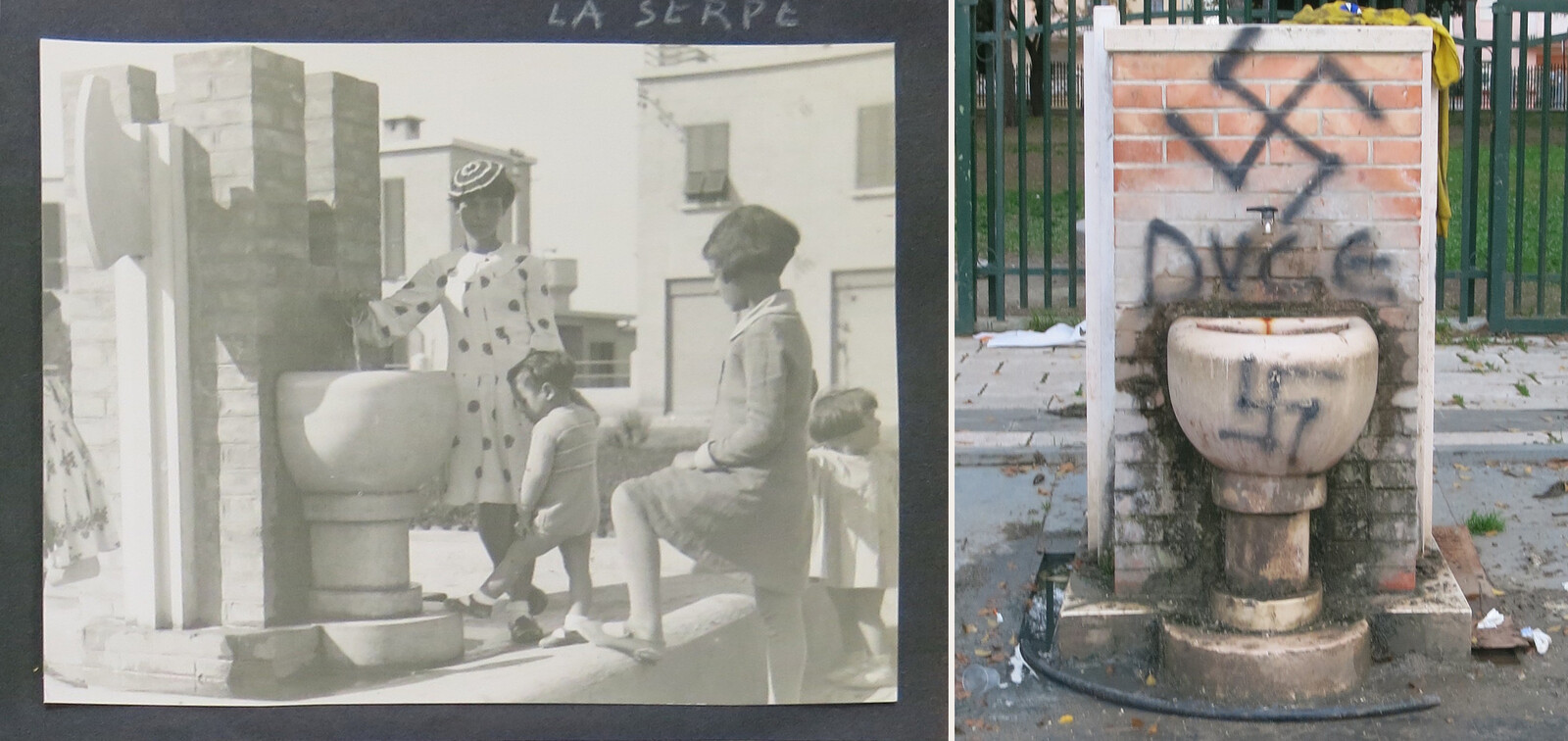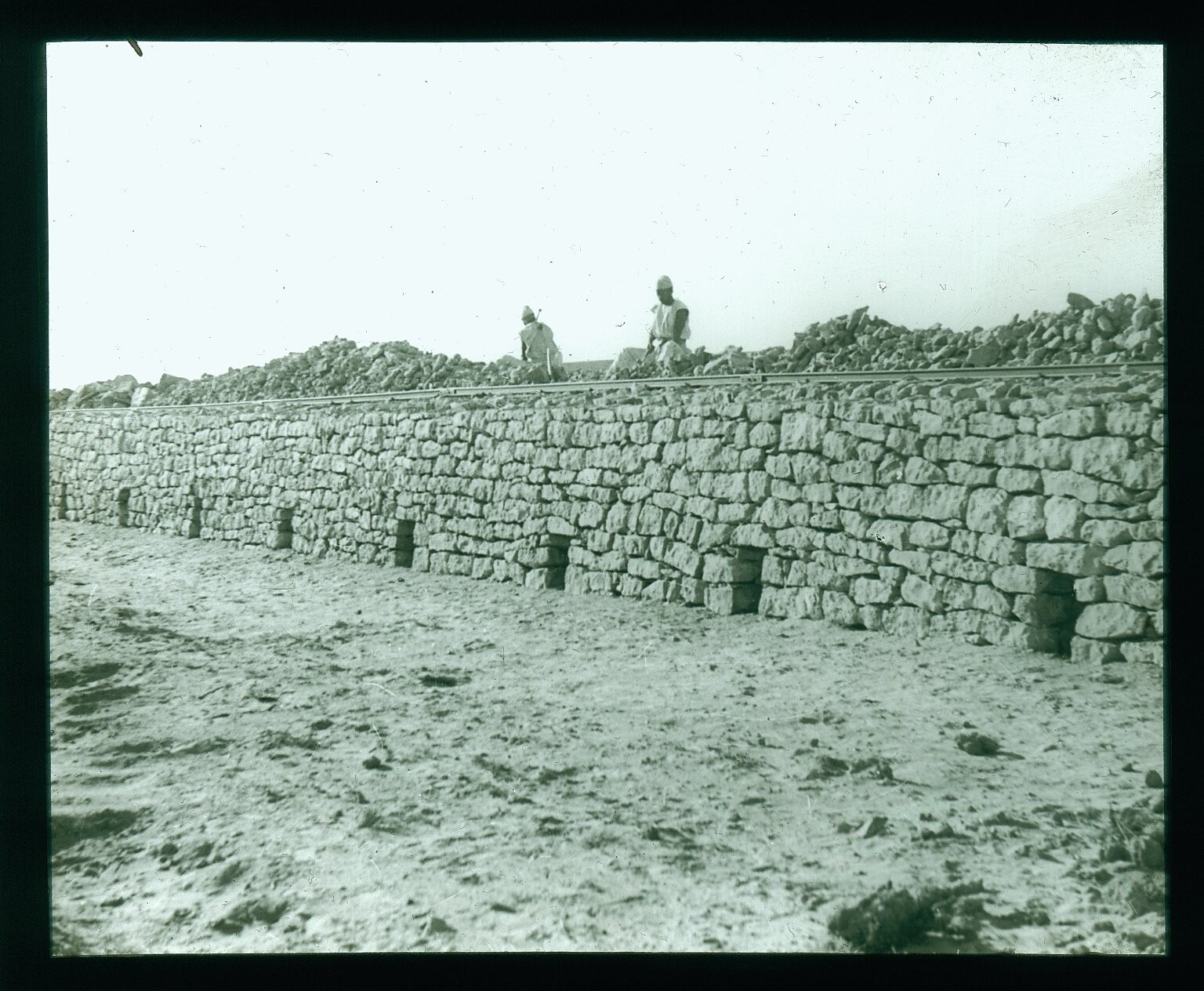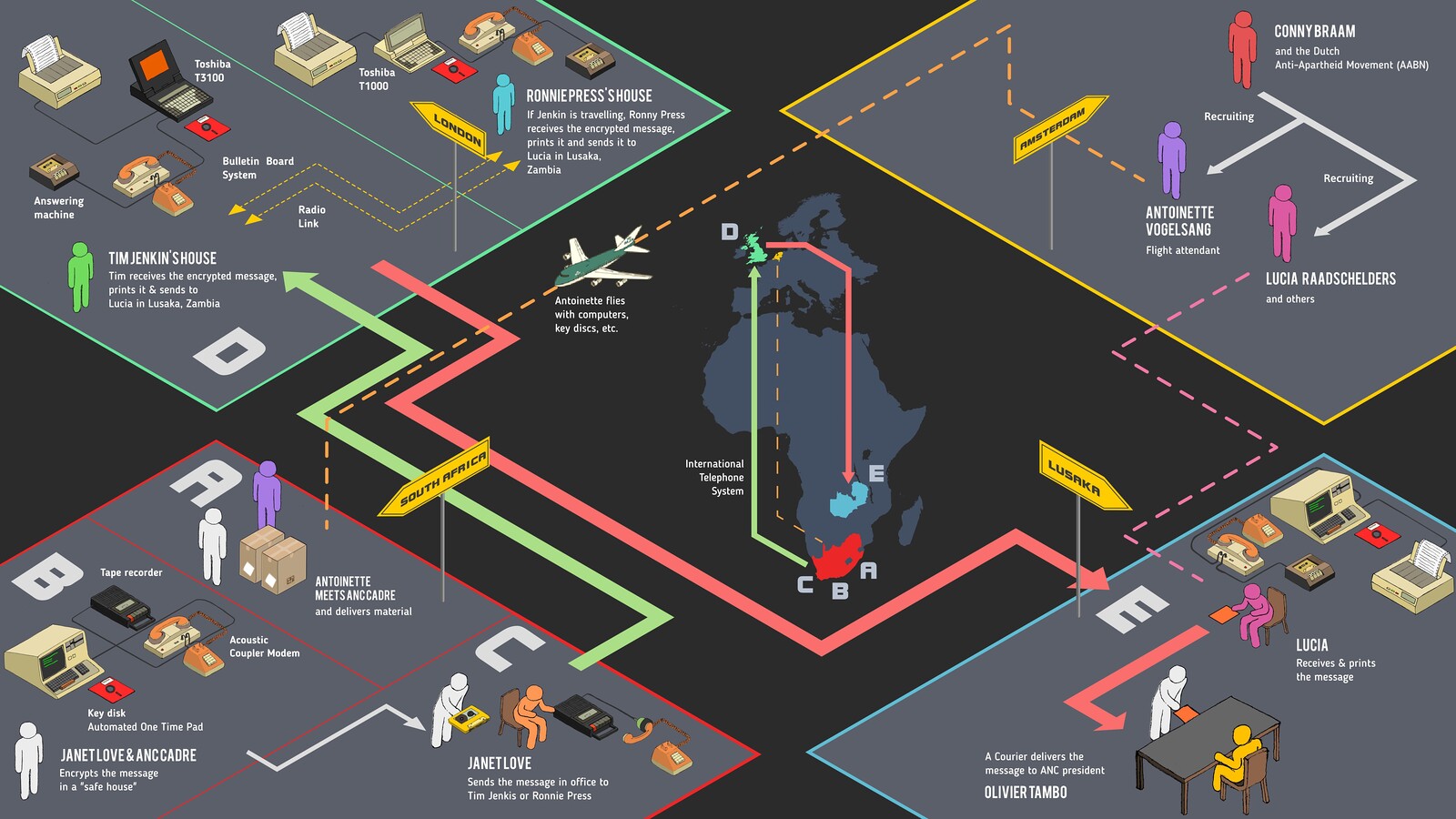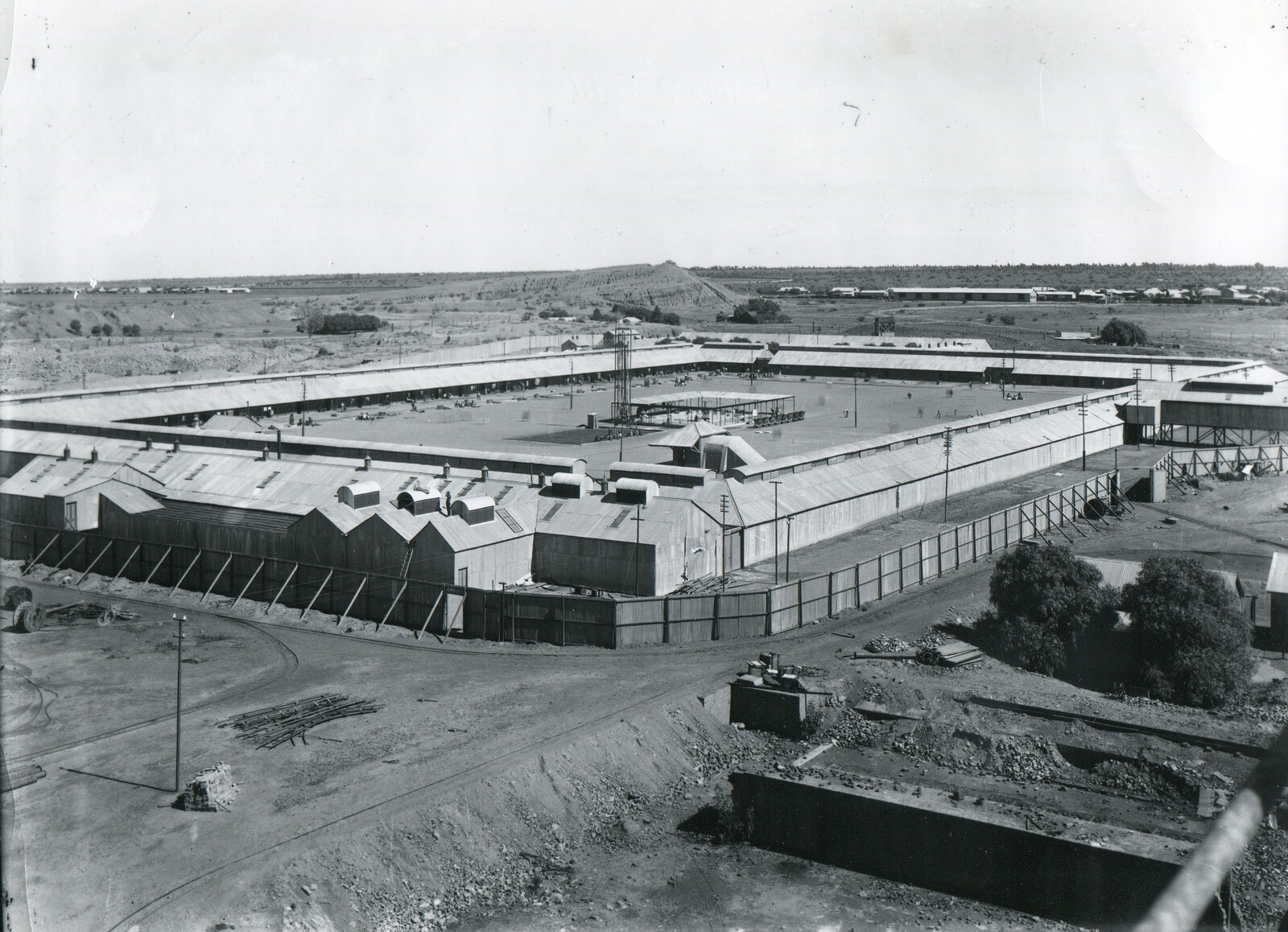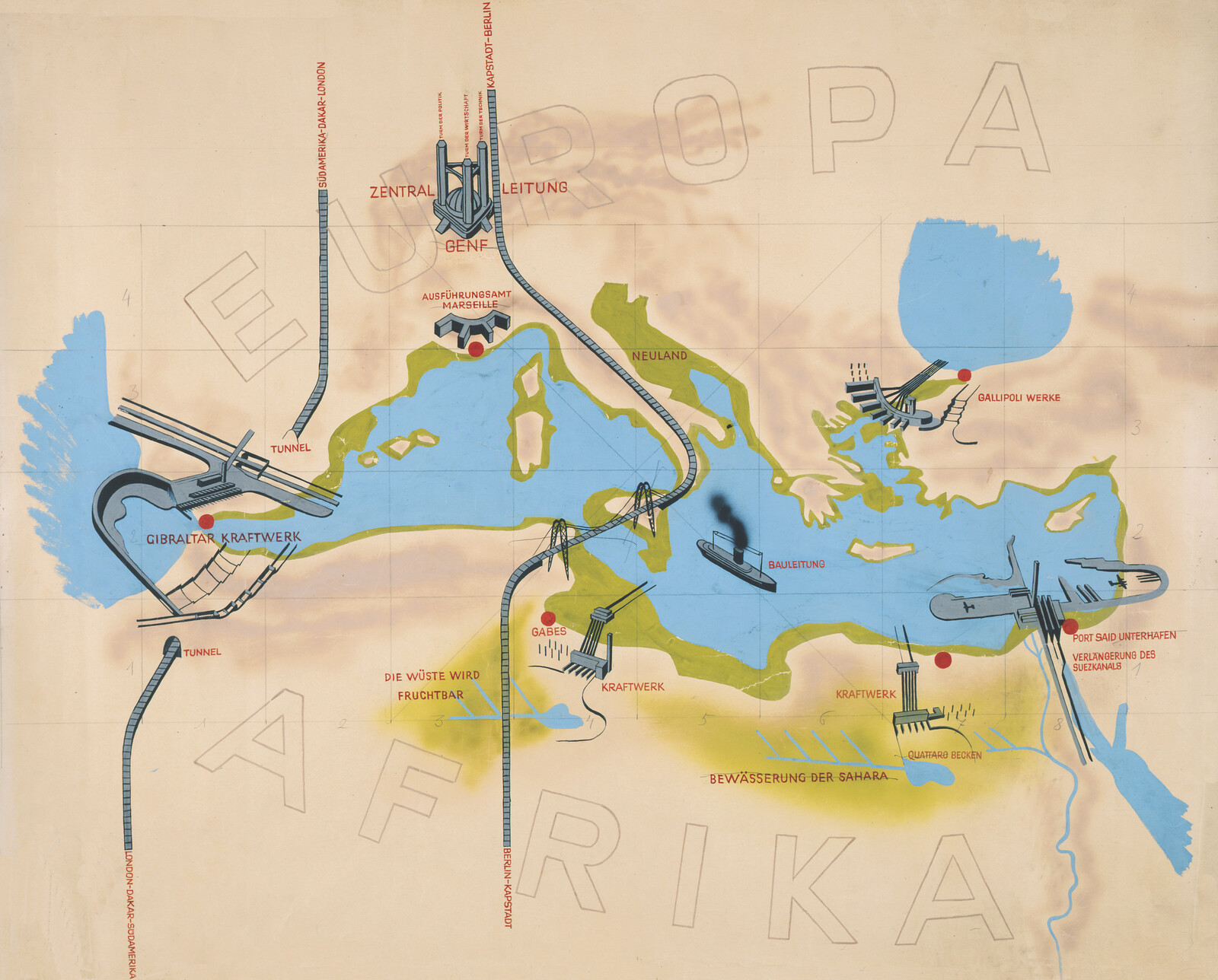The plain of Tavoliere, which makes up the largest portion of the district of Foggia, in the upper part of Italy’s southeastern Apulian region, today still bears the traces of a fascist infrastructural project of land reclamation that originally took shape in the 1920s and 1930s. Here, Mussolini’s regime had devised its largest feat of bonifica integrale (“integral cleansing,” or “reclamation”), following the much-acclaimed completion of drainage works and colonial-style settlement in Latium’s Pontine Marshes. Fascism’s overall project spanned various areas of “metropolitan” Italy and its overseas territories in Libya and East Africa, and aimed to fulfill the promise of land to peasants—a core element of its political platform in the aftermath of World War I—without upsetting that landowning elite that had supported the dictatorship’s rise to power. At the same time, these measures worked to quell internal opposition and build an international reputation. While the scheme became progressively innervated by partially new ideals of racial purity and unity, it built on previous experiments dating as far back as the late eighteenth century, and would outlive the downfall and formal repudiation of the fascist credo at the end of World War II. The spectral survival of these interventions on land, property, and people, which have stratified the landscape over the course of more than two centuries, haunt local agribusiness and its migrant workforce today.
Indeed, in the modern period Tavoliere (as well as other areas of Italy) underwent various iterations of land-tenure, agronomic, and hydraulic reorganization, leading up to the 1951 agrarian reform and the concomitant completion of large-scale irrigation infrastructure.1 Throughout their history and in their various guises, all of these projects were invariably associated with policy failure, bloody struggles, and mass outmigration. In their attempts to contain worker demands, suppress urban and peasant unrest, and increase the penetration of agro-capitalism through drainage, irrigation, agronomic innovation, and other measures, these centuries-old interventions fall within the sphere of (hydro)colonial imperial projects that, in the words of Stephanie Malia Hom, “surface, submerge, entangle, disappear, resurface, and infinitely loop back on themselves like a Möbius strip.”2
Today, the material, affective, and ideal afterlives of these projects can be discerned not just in Tavoliere’s landscapes, but equally in the discourses (and forms of governance) that revolve around its migrant population, especially around migrants from sub-Saharan Africa. Here, in the second-largest stretch of arable land in Italy, tens of thousands of farm workers (mainly from West Africa and Eastern Europe) are currently employed by agribusinesses, most notably in the multi-billion-euro, export-driven tomato industry established in the late 1970s. They are notoriously subject to multiple forms of violence, racism and exploitation.3 Those earlier interventions on Tavoliere’s lands, waters, and people, which ultimately enabled the development of intensive, irrigated, and high-value crop farming, are imbricated in current infrastructures for the containment, discipline, and management of a heavily racialized and segregated labor force.
Specters of bonifica in Tavoliere
Recently installed tent and container camps, decades-old and newly established slums, historic city neighborhoods, and abandoned farmhouses from the eras of bonifica and post-war agrarian reform are all inhabited or frequented by migrants today, most of whom are employed in the district’s farms. Such sites have become the stage (and trigger) for an uncanny reactivation of the old tropes and dispositifs that bore upon landless farmhands in earlier periods. Witness the obsessive demonization of the migrant farmworker population and the repeated calls to “cleanse” (bonificare) the shantytowns where many are forced to live, as well as the neighborhood adjoining the Foggia train station, which is a gathering point for migrant farmworkers who live outside or in the outskirts of the city. Fascist (and earlier) projects of bonifica reflected agrocapitalists’ and policymakers’ drive to rid town centers of the threatening (because organized and vocal) “rabble” of precariously employed and heavily impoverished farmhands living in unsanitary conditions. In the fascist-era plan, this was to be accomplished by resettling landless peasants in a series of farmhouses and hamlets, or borgate, built concentrically around Foggia.
In a bitterly ironic twist, besides labor camps, asylum-seeker reception centers, slums, and their hybrid in-betweens, the very borgate and farmhouses constructed by the fascist regime for rural settlers, now mostly in ruins, are themselves often (illegally) occupied by migrant farm workers. As if in a spiral movement, today the debris of settlements that were once deemed the solution to urban centers filled with unruly, untowardly farm laborers has become yet another instantiation of the same “problem.” Simultaneously, as recurrent complaints about migrant farm laborers’ presence in the center of Foggia testify, the same discourse persists within the urban spaces from which it originally sprung.
Furthermore, the specter of bonifica recurs not only in public statements about the need to “cleanse” city neighborhoods and slums of this allegedly nefarious, dangerous, and unhealthy presence, but also with reference to “immigration” more broadly. Such spectral echoes popped up in current Minister for Internal Affairs Luciana Lamorgese’s speech during a visit to the district of Foggia, occasioned by the meeting of the local Committee for Order and Public Security in December 2019. Among other issues, and in line with the largely securitarian approach to migration that has characterized Italian and EU policies since the 1990s, the Committee discussed the “plight” of the many farm laborer slums dotting Tavoliere. In the town hall of San Severo, in front of journalists and institutional representatives, the Minister stated: “I deem it necessary to have a bonifica, a bonifica of immigration, because we deal with the issue as one of emergency … but when emergency is every day, it is structural … Maybe we could have a quota system, because they come anyways, and we need them anyways, for the harvests, at certain periods in the year, we need a long-term vision.” The Minister, together with her cabinet colleague responsible for agriculture, was hinting at the project of an amnesty for undocumented migrants, which in Italy is usually referred to as a sanatoria—a legal term with evident biopolitical undertones implying the “curing” or healing of a metaphorical wound.4
Finally, in another perverse irony, the neo-fascist ideology that subtends many calls for a human and social bonifica often appeals to what has become commonly known as “the Kalergi plan,” a supposed conspiracy that involves politicians and other prominent figures (including, of course, George Soros) aimed at the “ethnic substitution” of white Europeans with (implicitly black and/or Muslim) migrants. On the walls of the city of Foggia it is common to spot posters, produced by far-right groups such as Forza Nuova, referring to the need to “stop the invasion” of migrants. While apparently reversing the content of Richard von Coudenhove-Kalergi’s proposals, whereby Europe should have sought in Africa its “natural” complement by means of settler colonization and resource extraction (rather than through African immigration into Europe, as neo-fascists claim), such conspiracy theories in fact partake of the logic underpinning the original Eurafrican ideal.5 Indeed, for the Paneuropean advocate, as much as for Italian proponents of the Eurafrican interwar utopia, the idea of an African presence in Europe was deemed nothing short of repulsive on unabashedly racist grounds.6 The biopolitical, racist, and natalist concerns (manifested in a contradictory preoccupation with declining fertility rates and perceived overpopulation) that informed those convictions are also the basis of current discourses about “ethnic substitution” and “empty cradles.”7
The coloniality of bonifica from the late eighteenth century to unification
Recent historiography has noted how “conventional historical differentiations between metropole and colony (such as those studied by historians of French or British Empire) are hard to sustain neatly in the Italian case.”8 Thus, “internal” and “external” colonization should be analyzed as related biopolitical, racialist projects that emerged together with Italy’s formal (but incomplete) unification in 1861.9 Yet, their genealogy can be stretched even further back. Already in the eighteenth century, the drive towards de-feudalization and the intensification of agriculture that led to numerous colonial-type schemes of population resettlement across Europe had also invested Tavoliere. In the former Kingdom of Naples, to which the region belonged, attempts at internal colonization began under Bourbon rule and continued into the post-unification period. In 1774, King Ferdinand IV had sought to establish a number of settler colonies in Tavoliere, known as I Cinque Reali Siti (“the Five Royal Sites,” which still exist today), populated by hundreds of landless peasants, many of whom were convict laborers. Conditions after colonization were far from ideal—lack of water and irrigation, of good housing, roads, and provisions, as well as high taxation and other contractual clauses unfavorable to colonists, led to the point where coercive means had to be employed to make sure farmers would not abandon the land, and those who defaulted on their dues were expelled.10 The eighteenth century also marked the emergence of an international discourse that assigned Italy’s Mezzogiorno—the southern part of the country—the status of a hybrid, exotic, and savage land straddling the civilizational divide between Europe and Africa.11 Enlightened scholars’ and policymakers’ incipient demonization of nomadic, transhumant pastoralism, which for centuries had been the principal economic activity of many parts of Italy, including Tavoliere, also fed into such representations, depicting shepherds as uncivilized brutes and the land itself as an inhospitable, desert wasteland.12 These tropes would remain at the center of colonial propaganda into the fascist era (1922–1943), although racist ideology as a whole would evolve across this period.13
After the 1815 restoration that put an end to the Napoleonic interlude, and just before their defeat, the Bourbons attempted yet another settler-colonial plan in Tavoliere, this time in San Ferdinando, a village that took the name of its founder, King Ferdinand II. While plans had been set in motion in 1831, it was not until 1847 that settler families were selected from the nearby salt marshes of Barletta. The salt-extraction establishment was the property of the crown, infested by malaria, and inhabited by poor salinari (workers of the salt pans) and smugglers who, several commentators alleged, had to be disciplined by attaching them to the land and the uplifting labor of agriculture.14 Although the site of the new colony seemed more favorable to human habitation and farming, the same issues as with the previous experiment emerged: lack of means of sustenance and of housing, indebtedness, officials’ corruption, and disease.15
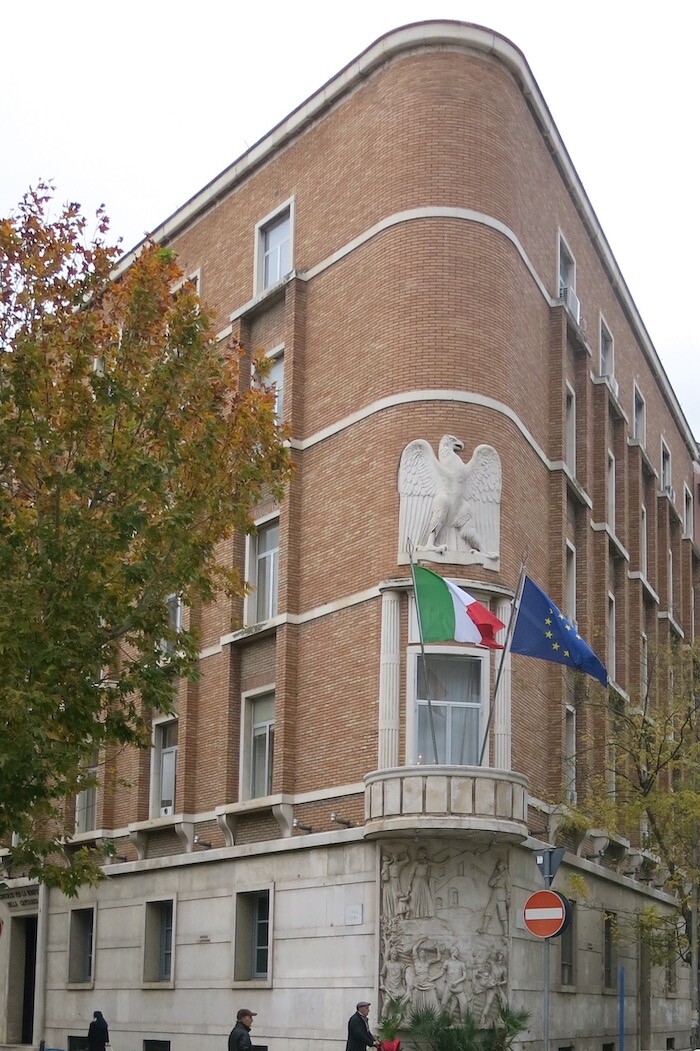

Headquarters of Foggia’s Reclamation Consortium (Consorzio di Bonifica), 1939. Photograph by the author.
With the defeat of the Bourbons that led to Italy’s unification under the Savoy crown, the frontier-like management of Mezzogiorno intensified, this time at the hands of northern capital. Industrialists and agrocapitalists benefited from the new kingdom’s operations of enclosure and transfer of wealth and assets from the deposed Bourbonic aristocracy.16 In Tavoliere, this process of primitive accumulation entailed the alienation of common pastures by the new rulers, which served to repay war debts and strengthened bourgeois-owned, capitalist latifundia, predominantly devoted to wheat cultivation.17 In the late nineteenth century, furthermore, the theories of prominent criminal anthropologists (most famously Cesare Lombroso’s, but also his disciple Alfredo Niceforo’s, among many others), in dialogue with those elaborated in the same period on the other side of the Atlantic, postulated the alleged inferiority of southern Italian populations as a whole. The peasants and herders of Mezzogiorno were thought to share common characteristics with Africans, and biological explanations were developed to justify their alleged inferiority and backwardness.18 The eighteenth-century trope of “Africanness” applied to Southern Italy and its inhabitants—most notably by Grand Tour travelers and foreign military officers—thus gained “scientific” status in the latter part of the nineteenth century.19
In the same period, most members of the elite argued that Italy’s aspirations to be considered on a par with its more powerful European neighbors necessitated the undertaking of a colonial venture to appropriate its “own” portion of Africa during the scramble and its aftermath. Colonial conquest began in earnest in 1885 and resulted first in the carving out of the territory to which the name “Eritrea” was given in 1890 (then lost to the British in 1941), followed by the annexation of Somalia (invaded in 1908 and partly controlled until 1960), and then Libya (1911–1943). The idea of creating agrarian colonies regained momentum within this context: both internal and external “colonization,” as they were explicitly called, were aimed at stopping the “hemorrhage” of outmigration and countering the population’s decreasing fertility rate, especially in rural areas, through a targeted natalist policy. Colonization also represented a way to quell social unrest and find new outlets for the ever-unresolved “southern question” that had erupted with unification.20
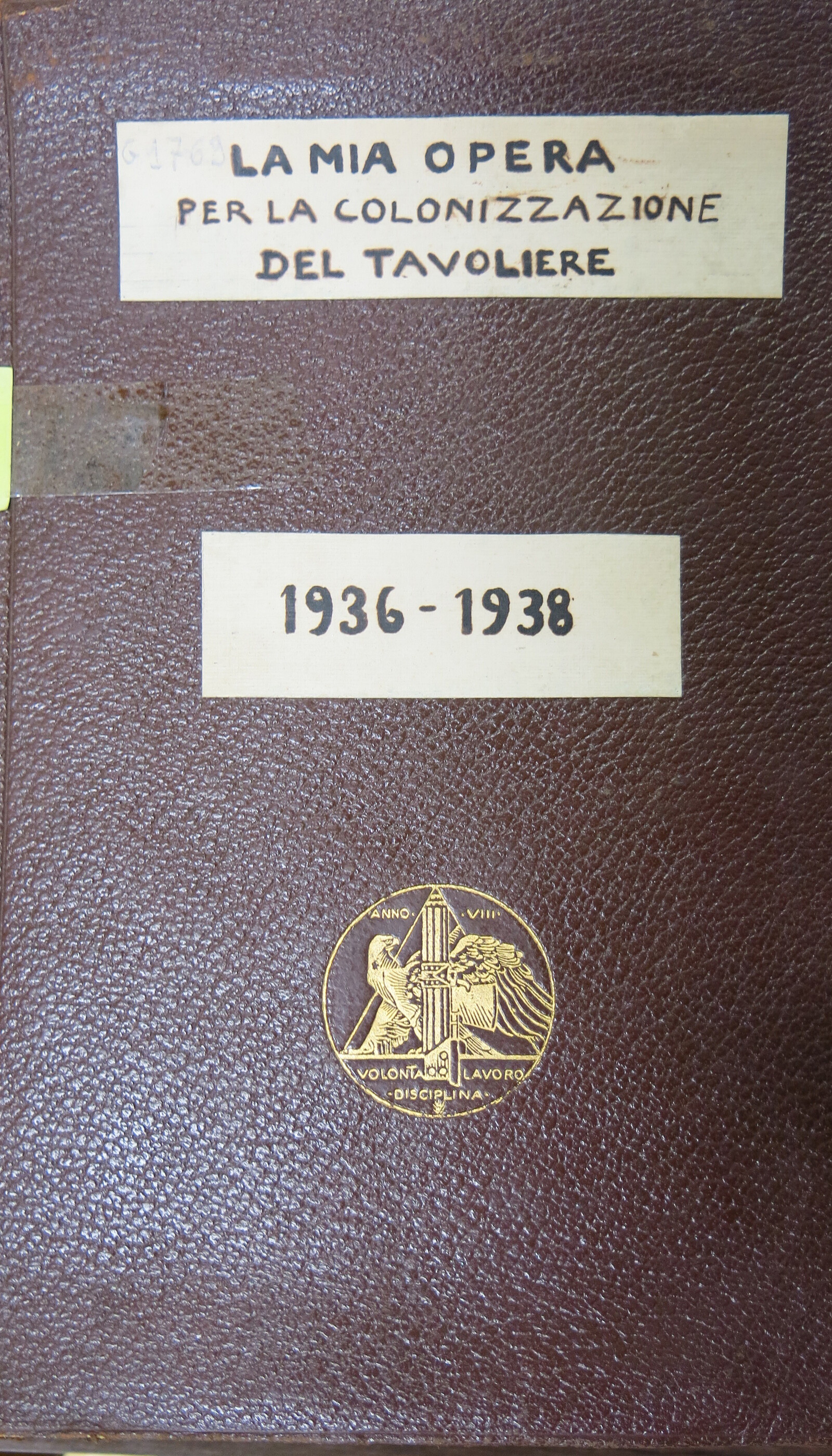
The private album collected by Rosario Labadessa, the fascist MP and commissioner of Foggia’s Reclamation Consortium and cadre of the National Veterans’ Association. The title reads: My work for the colonization of Tavoliere, 1936–1938.
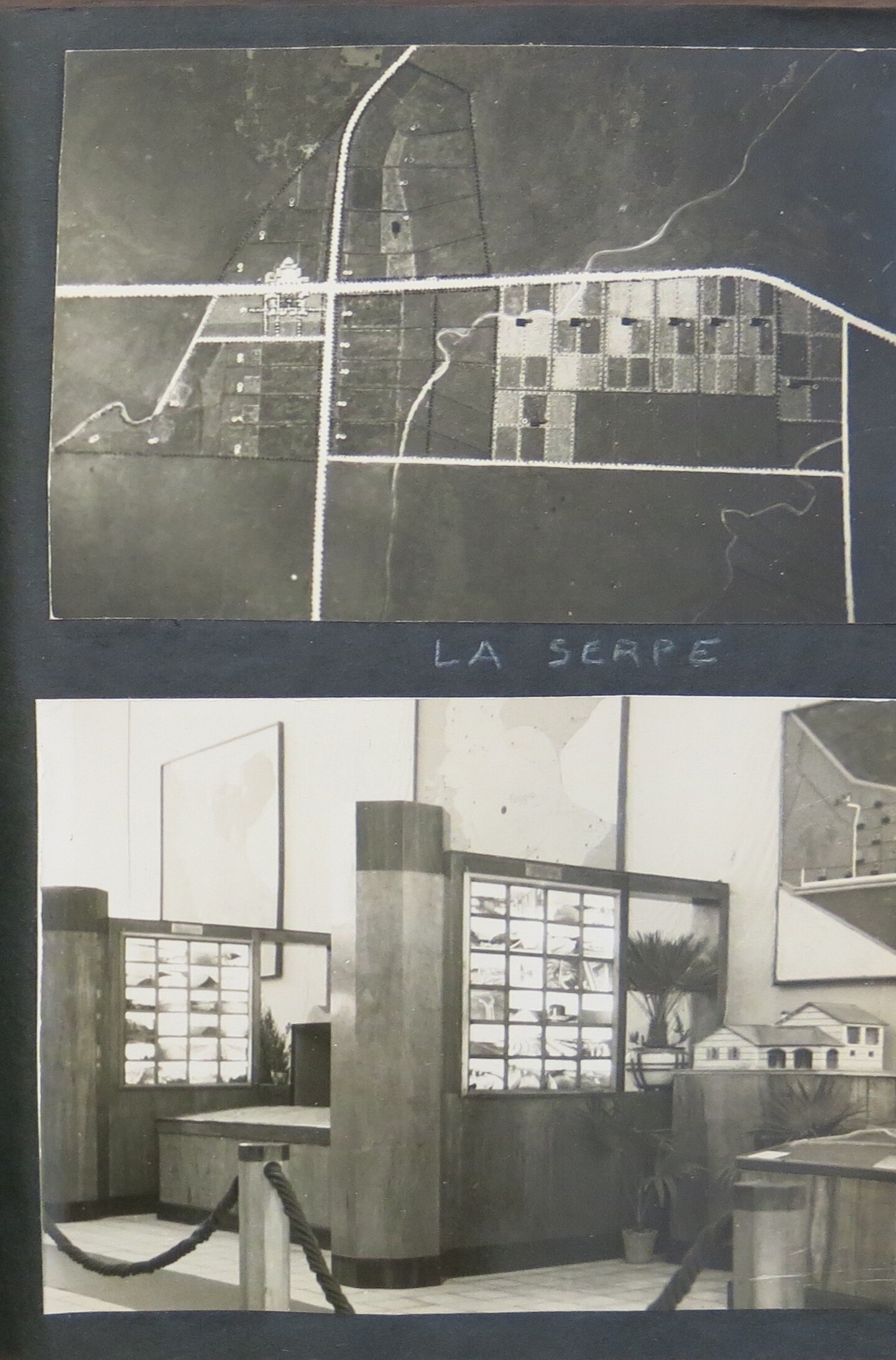
Photos of Borgo La Serpe/Mezzanone from the private album of Rosario Labadessa.
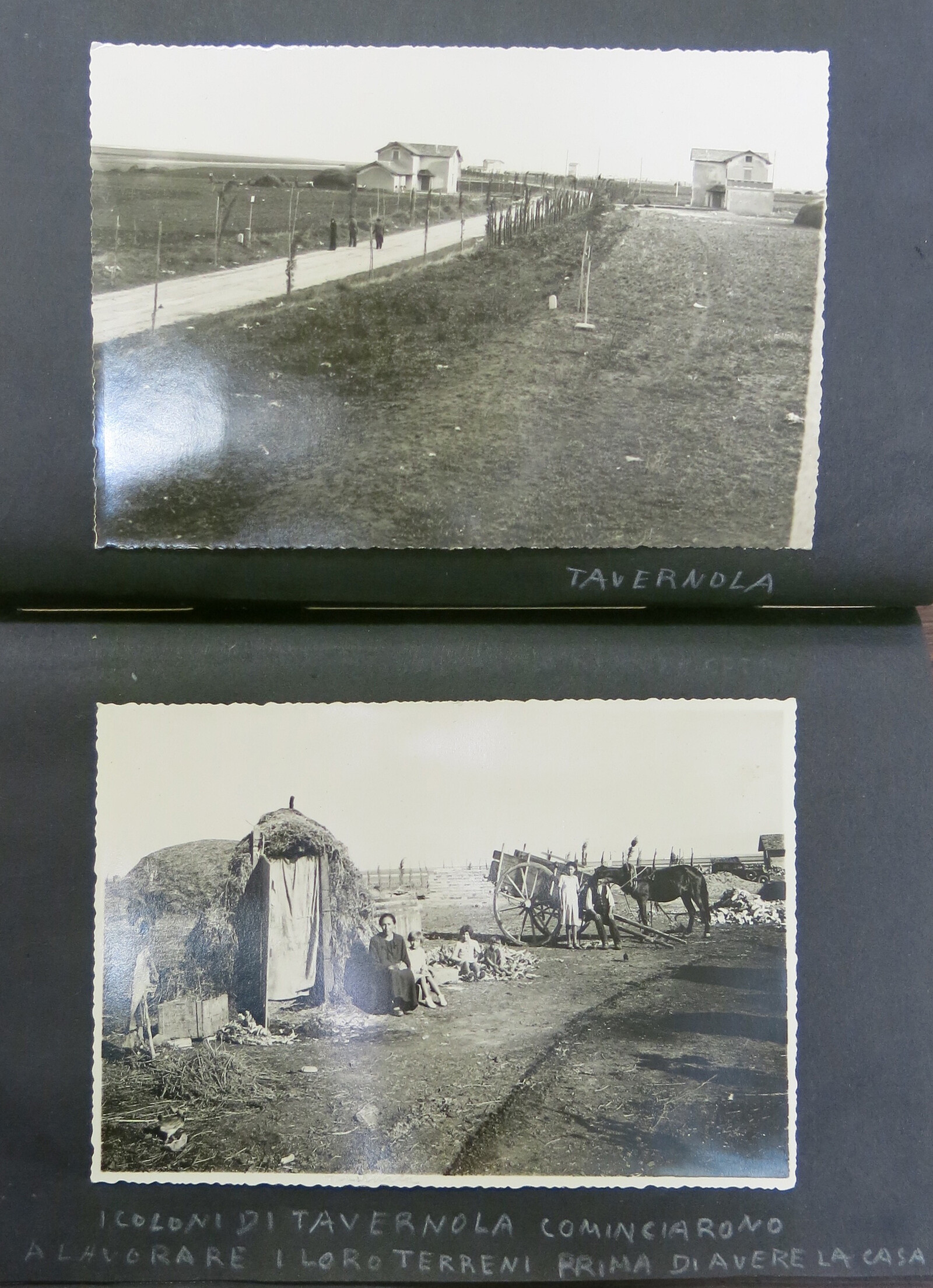
Photos of settlers in Tavernola, living in a self-constructed shack, from the private album of Rosario Labadessa. The caption reads: Tavernola’s colonists began working their land before receiving their house.
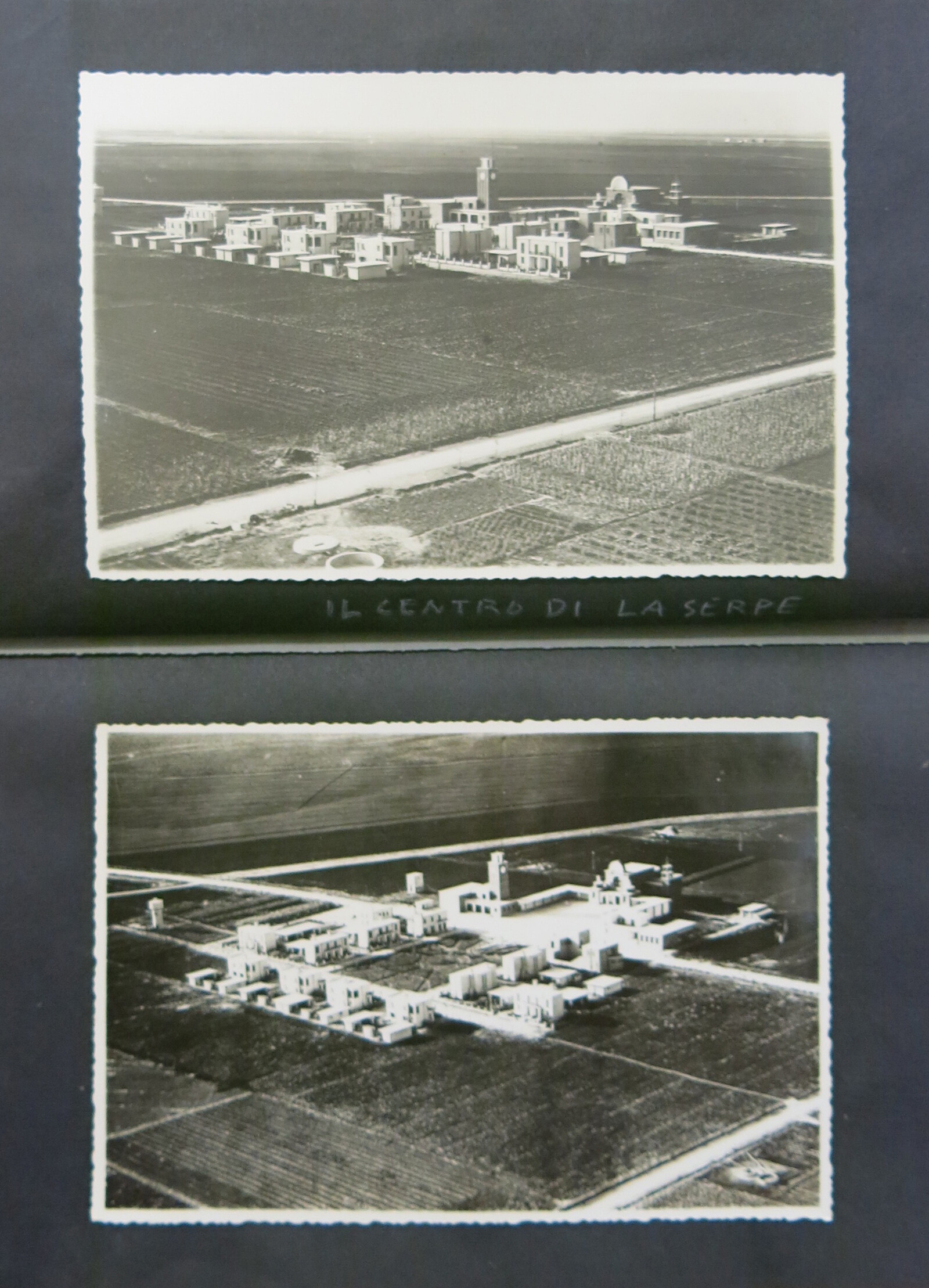
Photos of Borgo La Serpe/Mezzanone from the private album of Rosario Labadessa.
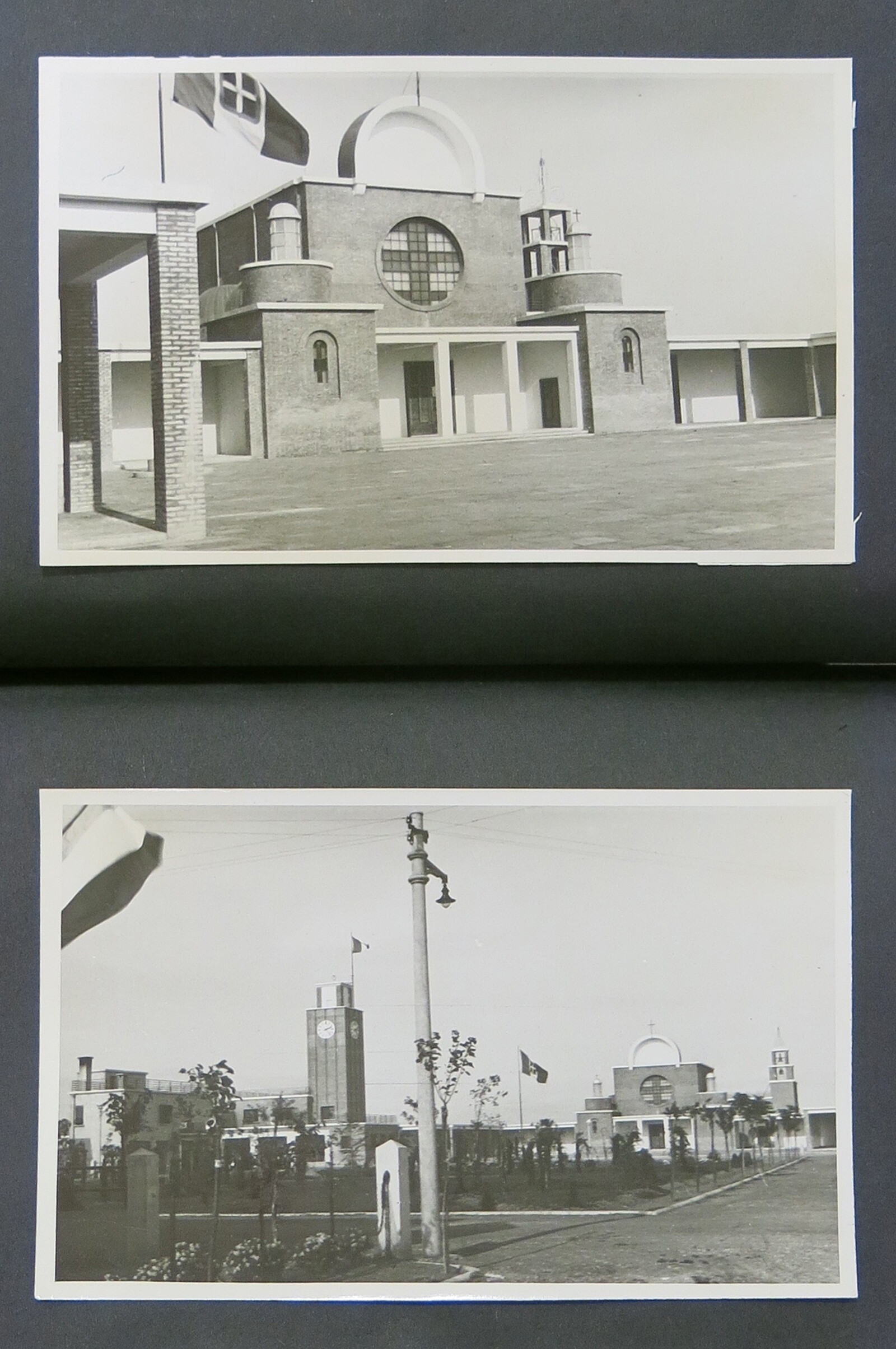
Photos of Borgo La Serpe/Mezzanone from the private album of Rosario Labadessa.
The private album collected by Rosario Labadessa, the fascist MP and commissioner of Foggia’s Reclamation Consortium and cadre of the National Veterans’ Association. The title reads: My work for the colonization of Tavoliere, 1936–1938.
Bonifica, the birth of Eurafrican dreams and their shattering
From the turn of the twentieth century until the end of fascism, projects were launched for the reclamation of swampy lands, mostly along the Italian coastline and in the overseas territories, coupled with increasingly “organic” visions in which demographics, politics, and racial science converged.21 Across internal and external colonies, building irrigation and agrarian infrastructure was considered key to the all-encompassing civilizing mission, founded on the engineered resettlement of a large number of people. The lands to be reclaimed and colonized by Italian peasants were depicted as abundant, empty, and fertile, and the colonizing attitude of Italians was presented as “proletarian” and “humane” in comparison with the ruthless and exploitative character of its British and French equivalents.22
Throughout the post-unitary period and until the rise of fascism, however, such projects remained largely unaccomplished and were unanimously labelled as failures, on account of deficiencies in the design of infrastructure coupled with emergency-type interventionism, political conflicts, unsuitable geographies and climates, and scarce knowledge of the colonial terrain. Before fascism, the rare experiments in demographic colonization, limited to Eritrea and to a few areas in mainland Italy, were mostly the result of individual initiative and rather short-lived. It was only during the fascist regime that new life was given to their implementation, spurred by a geopolitical, vitalist ideology often subsumed under the label of “Eurafrica,” which considered it a people’s right to expand in accordance with its demographics and “youth,” indexed by its fertility and “creative powers.” While Italy’s fertility rate was in constant decline, and emigration had continued unabated until legal restrictions were enforced in both receiving and sending countries, fascist propaganda somewhat contradictorily justified its imperial aims with the need to find accommodation for the country’s supposed “overpopulation,” a term that in fact masked the plight of unemployment and social unrest. At the heart of these projects of colonization was the regime’s aim to “ruralize” the masses of the urban poor, perceived as a political threat, at a time when the great economic crisis of 1929 had exacerbated the effects of the Great War. Discourses about Italian colonialism as a demographic, humane, and proletarian endeavor—as opposed to the extractivist operations of “plutocratic” regimes—were given new vigor and proposed as countermeasures to face the emerging American and Asian imperial power blocs.
Like other European powers, Italian fascists deemed Africa the remedy—a natural prosthesis of Europe, abundant in resources and poor in terms of human capacities. Beyond the international conflicts underscoring the colonial rush, similar tropes, discourses, imageries, and bodies of knowledge circulated in fascist Italy as in other European countries concerning their (naturally colonial) relation to Africa.23 At the same time, foreshadowing the global conflict to come, fascist intellectuals increasingly distanced themselves from Paneuropean ideals and “Eurafrican” anthropology to espouse their own brand of Eurafricanism, especially after the proclamation of the Racial Manifesto and the ensuing racial laws in 1938.24 Just as in allied Nazi Germany, rural populations were portrayed as the most perfect emblems and defenders of a newly discovered “Aryan” racial purity, which simultaneously fueled an explicit attempt to bring in a “New Order” and thus a “new man.”25 In the period inaugurated by Mussolini’s 1927 “Ascensione” speech, the perceived “racial” divisions between northern and southern citizens that had characterized the early history of the nation were now the object of policies for the “material fusion” of Italians into a single “race.”
The experimental terrains for the creation of such racially superior individuals were precisely those lands reclaimed through large infrastructural projects of bonifica. The reclamation of malaria-infested swamps was part of a much broader biopolitical project of wholesale, organic renovation and cleansing of the nation (bonifica integrale). The human component (bonifica umana) was the object of racist and eugenic projects of social engineering that contemplated resettlement on newly reclaimed lands. The “agro-towns” that had developed in parallel with agrarian capitalism (particularly with the increase of labor-intensive wheat cultivation in the latter half of the nineteenth century) were to be “cleansed” (bonificate) of the landless farmhand rabble, who needed to be installed close to the land in order to be reformed and elevated.26
Thus, swamps were dried up; roads, canals, and irrigation networks were built; and houses, villages, and towns were erected for the resettlement of thousands of families, first on Italian soil and later in the newly proclaimed “Empire” (1936). Infrastructural projects, architectures, and people throughout these territories were designed based on the same guiding principles, bringing both internal and external colonization under the management of a single institute (the Commissariat for Migration and Internal Colonization, CMCI). Settler families were selected according to such criteria as loyalty to the regime, members who had participated in the Great War, size (and thus “fertility”), and aptitude for the cultivation of the land.
While the most celebrated instances of such resettlement schemes on Italian territory related to the projects of bonifica in Latium and Sardinia, Tavoliere was the site of early and significant experiments that took place from the early 1920s to the mid-1930s, before the large-scale reclamation works in the region were delayed by the Ethiopian campaign of 1935–1936. In 1922, the Italian Agrarian Culture Company (SICA) leased hundreds of hectares of land in various parts of Tavoliere, which it improved by apportioning them out to several families of sharecroppers originally from the Marche region, thus anticipating the resettlement policies of the following decade.27 In Margherita di Savoia (formerly known as the Royal Saline of Barletta, which Ferdinand II had sought to rid of some of its troublesome, indigent population), the Electrical Company for Reclamation and Irrigation (Società Elettrica per la Bonifica e l’Irrigazione) established an experimental farm in 1927, initially relying on sharecroppers from the neighboring village of San Ferdinando.28 The heirs of the 1847 Bourbon colony were thus the object of yet another experiment and relocation, as later (in 1935 and 1937, respectively) they would also move to the newly founded borgate of La Serpe and Tavernola.29 However, starting from 1932, the experimental farm of Santa Chiara in Margherita di Savoia would be settled by fourteen landless peasant families from the Veneto region, each counting fifteen to twenty members. These were first employed in reclamation works and subsequently allocated their own pieces of land, totaling 200 hectares, on which the first attempts at horticulture were made, including the growing of tomatoes.30 Later, reclamation work in Tavoliere would be carried out predominantly by landless peasants recruited locally or from neighboring districts and regions.
Some of the settlers in Azienda Santa Chiara were veterans demobilized from the African colonial wars (the brutal “pacification” of Libya completed in 1934, and the invasion of Ethiopia in 1935), or migrants recruited for the agrarian colonization of Libya who had subsequently returned to their homeland only to find that their entire family had relocated to Apulia.31 Once again, the continuities between “internal” and “external” forms of colonialism emerge, even from the biographies of some of the protagonists. The regime also envisaged a reverse movement, in which peasants who had been resettled across reclaimed lands in Italy would go on to colonize Libya and the newly acquired imperial territories of Ethiopia. Several institutional bodies were created for this purpose, including the Colonization Authority of Apulian Ethiopia (Ente Colonizzazione Puglia d’Etiopia, 1938), which was charged with selecting Apulian families and supporting them in the initial phases of settlement in the Ethiopian highlands.32 A military ethos pervaded not only the overseas project of colonization but also the internal one, crystallized in the well-worn imagery of “the plough and the sword” from ancient Roman iconography, relayed ad nauseam by fascist propaganda about land reclamation and settler schemes.33
Despite the immense infrastructural investment in Ethiopia (employing more than 200,000 workers between 1935–1939 for the building of roads and bridges and the reclamation of land), a limited number of colonists (less than 1,000 in 1938 and 1939) followed, marking another failure and demonstrating the propagandist nature of fascist colonial ambitions. Apulian settlers in Ethiopia amounted to 196 household leaders, who were in charge of pioneer work and military defense. Only fifteen of them would later be joined by their whole families. The men had to be between 22 and 45 years old, healthy, with family responsibilities, and experienced in farming (landless farmhands were deemed unsuitable to run a farm). Preference was given to those who had participated in the military expedition in Italy’s East Africa. The venture suffered from a progressive loss of credibility, with clashes emerging between agronomists and other technical and political figures, and many settlers quickly returned to the homeland. Even as selection grew stricter (especially on political grounds), the process remained hasty, seeking to ride the propagandist wave that followed the conquest of Ethiopia after years of promises, notwithstanding a widespread awareness of its ongoing failures.34 In Tavoliere, conversely, by the end of 1941, 1,217 plots had been set up, 33,563 hectares reclaimed, and 10,680 people settled.
However, even when immediately successful in resettling large numbers of peasants, colonial aspirations based on biopolitical Eurafrican projects resulted in overall failure: returns, abandonments, indebtedness, and unfinished projects characterized the later years of bonfica.35 After the Second World War, the agrarian reform sought to continue the reclamation and infrastructural work undertaken by the fascist regime, albeit purified of its racial undertones. Its scarce results (mainly due to the insufficient size of allotments) once again paved the way for mass outmigration and a later influx of the cheap, marginalized migrant workforce demanded by restructured agribusiness. The 1950s agrarian reforms represented the tail-end of an outmoded ruralist ethos, which in the following decade would make way for industrialist and urban-centered interventions.
In postwar Tavoliere, completion of the fascist reclamation project, and particularly the design of residential villages, was entrusted to Nallo Mazzocchi Alemanni—the same agronomist-urban planner who, in 1936, had laid out the colonization plans for the farms that Opera Nazionale Combattenti (ONC, the Great War Veterans’ Association, which had accomplished most of the reclamation schemes across different districts) was to build in Ethiopia.36 After the end of the war, some settlers of the Azienda Santa Chiara would be yet again transferred, becoming employees of the same ONC in another borgata of Tavoliere (Incoronata). Others preferred to move back north and find employment in the factories of Lombardy and Veneto. All were defrauded of their right to become owners of the land they had farmed as sharecroppers, as the agrarian reform had proposed, and their last remaining descendants, who had continued to farm the land and live in the Azienda, were finally expelled in the spring of 2021.
Mass outmigration from Tavoliere (and other parts of rural Mezzogiorno) towards northern Italy’s industrial centers, or further afield, also marked the re-emergence in the 1950s of anti-southern rhetoric and sentiment, rekindled yet again in the 1990s by the Northern League (later Lega) party, together with hatred against transnational migrants. Meanwhile, several borgate built by the regime in Tavoliere, such as Giardinetto, have recently been used as illegal dumping grounds, testifying to the current abandonment of lands once deemed central to Italy’s ascendancy, and revealing the disconnect with a past that has never been fully acknowledged.
This form of foreclosure, spanning the periods of fascism and the transition to parliamentary democracy and industrialism, has left Tavoliere’s borgate and farmhouses to house new abject populations. While the African presence has become a reality, materializing one of the fascists’ (and, more generally, racists’) worst nightmares, the underlying premises of colonization are still very much alive, marking spaces and bodies according to notions of civilization, hygiene, and appropriateness that resonate with past projects and rhetorics. The genealogy of current spaces and discourses for the containment of migrants, many of whom are employed in the farming sector, shows how the spatial, legal, and symbolic-affective dimensions that create and reproduce such dispositifs partake of a racialist, biopolitical logic—one that has been repeatedly disavowed but continues to survive in spectral form.
Leandra D’Antone, Scienze e governo del territorio: Medici, ingegneri, agronomi, urbanisti nel Tavoliere di Puglia, 1865–1965 (Milan: Franco Angeli, 1990).
Stephanie Malia Hom, Empire’s Mobius Strip: Historical Echoes in Italy’s Crisis of Migration and Detention (Ithaca: Cornell University Press, 2019). I would like to thank Pamela Ballinger for suggesting this reference. On the notion of “hydrocolonialism” see Isabel Hofmeyr, “Provisional Notes on Hydrocolonialism,” English Language Notes 57, no. 1 (2019): 11–20.
Elsewhere I have dealt with the (much spectacularized) conditions of labor and life of these sectors of the workforce, and on the infrastructures of governance, extraction, and resistance underlying them, in more detail. See: Irene Peano, “Emergenc(i)es in the fields: Affective composition and counter-camps against the exploitation of migrant farm labour in Italy,” in Impulse to Act: A New Anthropology of Resistance and Social Justice, ed. Othon Alexandrakis (Bloomington: Indiana University Press, 2016); Irene Peano, “Global care-commodity chains: Labour re/production and agribusiness in the district of Foggia, southeastern Italy,” Sociologia del Lavoro 146 (2017): 24–39; Irene Peano, “Ways of making a human otherwise: After-ethnography with migrant labourers in Italian agro-industrial enclaves,” in Modos de Fazer/Ways of Making, ed. Vítor Oliveira Jorge (Porto: CITCEM, 2020); Irene Peano, “Turbulences in the encampment archipelago: Conflicting mobilities between migration, labour and logistics in Italian agri-food enclaves,” Mobilities (February 2021): 1–12; Francesca Esposito et al., “Fragmented Citizenship: Contemporary Infrastructures of Mobility Containment along Two Migratory Routes,” Citizenship Studies 24, no. 5 (2020): 625–641.
See l’Attacco TV, “Lamorgese: ‘Riteniamo che Foggia abbia bisogno di un’attenzione particolare del Governo,’” YouTube, December 23, 2019, ➝. For references to bonifica in relation to slums, camps, and city neighborhoods, see, for example, “Infiniti pericoli e degrado, l’inferno dell’ex pista non è più tollerabile: ‘Si apra il Cara agli stranieri regolari,’” FoggiaToday, June 1, 2020, ➝; “Gran Ghetto distrutto: testimonianze sull’incendio, la polizia indaga su cosa è accaduto prima del devastante rogo,” FoggiaToday, December 6, 2019, ➝.
Richard von Coudenhove-Kalergi, Paneuropa (Vienna, 1923).
Peo Hansen and Stefan Jonsson, Eurafrica: The Untold History of European Integration and Colonialism (London: Bloomsbury, 2014). See, for example, many of the articles in the propaganda magazine Africa Italiana, published from 1938 to 1943.
See: Elizabeth Krause, “‘Empty Cradles’ and the Quiet Revolution: Demographic Discourse and Cultural Struggles of Gender, Race, and Class in Italy,” Cultural Anthropology 16, no. 4 (2001): 576–611; Milena Marchesi, “Reproducing Italians: Contested Biopolitics in the Age of ‘Replacement Anxiety,’” Anthropology & Medicine 19, no. 2 (2012): 171–188.
Mia Fuller, “Italy’s Internal and External Colonies,” in A Moving Border: Alpine Cartographies of Climate Change, eds. Marco Ferrari, Elisa Pasqual, and Andrea Bagnato (New York: Columbia University Press, 2019). See also: Pamela Ballinger, The World Refugees Made: Decolonization and the Foundations of Postwar Italy (Ithaca: Cornell University Press, 2020); Carmine Conelli, “Razza, colonialità e nazione: Il progetto coloniale italiano tra Mezzogiorno e Africa,” in Quel che resta dell’impero: La cultura coloniale degli italiani, eds. Valeria Deplano and Alessandro Pes (Milan: Mimesis, 2014); Roberta Pergher, Mussolini’s Nation-Empire: Sovereignty and Settlement in Italy’s Borderlands, 1922–1943 (Cambridge: Cambridge University Press, 2017).
The annexation of the last territories that were deemed “naturally” Italian would take place during the Great War, and the incomplete unification project (including a “mutilated victory” in World War I) was indeed one of the leitmotifs of what would become the fascist movement.
Antonio Ventura, I “Reali Siti” del Tavoliere: Dalle cinque colonie alla città sovracomunale dell’Unione, contributi documentari, librari, letterari (Foggia: Grenzi, 2013); Raffaele Ciasca, Storia delle bonifiche nel Regno di Napoli (Bari: Laterza, 1928), 76–83.
Nelson J. Moe, The view from Vesuvius: Italian culture and the southern question (Berkeley: University of California Press, 2002).
For examples of such attitudes in this period, see: Melchiorre Delfico (1788), cited in Ventura, I “Reali Siti,” 14; Giuseppe Palmieri (1789, 1792), cited in Ventura, I “Reali Siti,” 16, 126–27; Francesco Mercurio, “Agricolture senza casa: Il sistema del lavoro migrante nelle Maremme e nel Latifondo,” in Storia dell’agricoltura italiana in età contemporanea, I: Spazi e paesaggi, ed. Piero Bevilacqua (Venice: Marsilio, 1989).
See: Le bonifiche in Italia dal ‘700 a oggi, eds. Piero Bevilacqua and Manlio Rossi-Doria (Rome: Laterza, 1984). See also the short film released by the regime’s Istituto Nazionale Luce, La bonifica del Tavoliere, 1940, ➝. For the overseas equivalents of these discourses in colonized Libya, see Hom, Empire’s Mobius Strip.
In the same period, the coastal lake adjacent to the marshes was the object of another project of reclamation through drainage, one of the most ambitious for the period. The salinari and smugglers were the object of debate among the reformers of the time. See, for example, Saverio Russo, “La bonifica del lago Salpi, in Capitanata,” L’ambiente storico 8–9 (1985–1986): 119–135.
See: Rosario Labadessa, Il Tavoliere di Puglia dalla pastorizia all’agricoltura: Esperimenti borbonici di colonizzazione (Rome: Casa Editrice Pinciana, 1933); Savino Defacendis, Nuovi contributi alla storia di San Ferdinando di Puglia (San Ferdinando di Puglia: Archeoclub d’Italia, 2011).
Marta Petrusewicz, “Before the Southern Question: ‘Native’ Ideas on Backwardness and Remedies in the Kingdom of Two Sicilies, 1815–1849,” in Italy’s Southern Question: Orientalism in One Country, ed. Jane Schneider (New York: Berg, 1998). See also the well-known essay: Antonio Gramsci, “Notes on the Southern Problem and on the Attitudes Toward It of Communists, Socialists and Democrats,” 1926.
Frank Snowden, Violence and Great Estates in the South of Italy: Apulia, 1900–1922 (Cambridge: Cambridge University Press, 1986).
See: Mary Gibson, “Biology or Environment? Race and Southern ‘Deviancy’ in the Writing of Italian Criminologists, 1880–1920,” in Schneider, ed., Italy’s Southern Question, 99–115; Nicoletta Poidimani, Difendere la “razza”: Identità razziale e politiche sessuali nel progetto imperiale di Mussolini (Rome: Sensibili alle Foglie, 2009); Vito Teti, La razza maledetta: Origini del pregiudizio antimeridionale (Rome: manifestolibri, 2011).
Conelli, “Razza, colonialità e nazione.”
Conelli, “Razza, colonialità e nazione.”
See: Le bonifiche in Italia dal ‘700 a oggi; Poidimani, Difendere la “razza”; Maria Rosa Protasi and Eugenio Sonnino, “Politiche di popolamento: Colonizzazione interna e colonizzazione demografica nell’Italia liberale e fascista,” Popolazione e Storia 1 (2003): 91–138.
The propaganda of the time, up until the end of the fascist period, is full of such claims. For an overview, see, for example, Mia Fuller, Moderns Abroad: Architecture, Cities and Italian imperialism (London: Routledge, 2006).
At its root, the concept of Eurafrica “was derived from anthropology and ethnology, especially the works of Italian anthropologist Giuseppe Sergi. Basing his theory on physical anthropology, Sergi rejected the idea that the peoples of Europe were of Aryan or Caucasian descent, but argued that Europe’s population originated in Africa. There was thus one single ‘Eurafrican species.’” Hansen and Jonsson, Eurafrica, 32, footnote 30.
“Il fascismo e i problemi della razza,” Il Giornale d’Italia, July 14, 1938, republished as “Il Manifesto della razza,” La difesa della razza 1, no. 1 (1938): 2.
Poidimani, Difendere la “razza.”
See: Anton Blok, “South Italian Agro-Towns,” Comparative Studies in Society and History 11, no. 2 (1969): 121–135; Snowden, Violence and Great Estates.
Giuseppe Barone, Mezzogiorno e modernizzazione: Elettricità, irrigazione e bonifica nell’Italia contemporanea (Turin: Einaudi, 1986), 283.
Enrico Pantanelli, L’azienda irrigua di S. Chiara (Florence: Tipografia Classica, 1929).
Gianfranco Piemontese, Urbanistica ed Architettura nel Tavoliere delle Puglie: L’esperienza dei Centri rurali 1929–1942 (Foggia: Grenzi, 2010), 42, 65–66.
See, for example, Duilio Paiano, Quando a scuola andavo in bicicletta (Foggia: Parnaso, 2014), 48–49, 67. See also a short documentary film, Angelo Casto, Strani Migranti (Aranciafilm/RegionePuglia, 2007), ➝.
Personal communication from a descendant of the original settlers, Foggia, July 2021.
Lucia D’Ippolito, “L’ente di colonizzazione Puglia d’Etiopia,” in Fonti e problemi della politica coloniale italiana, vol. II (Rome: Ministero per i Beni Culturali e Ambientali, 1996), 488–518.
See, for example, Federico Caprotti, “Scipio Africanus: Film, internal colonization and empire”, cultural geographies 16 (2009): 381–401.
At the same time, a massive population transfer took place towards Libya (including 235 people from Foggia) in the same years (1938–1939). See “1800 famiglie nei nuovi villaggi libici: Una flotta di diciassette piroscafi trasporterà il 29 ottobre i ventimila coloni,” Corriere della Sera, 1938.
See: Ballinger, The World Refugees Made; Riccardo Mariani, Fascismo e “città nuove” (Milan: Feltrinelli, 1976).
D’Antone, Scienze e governo del territorio, 193–194, footnote 50.
Coloniality of Infrastructure is a collaboration between e-flux Architecture, Critical Urbanisms at the University of Basel, and the African Centre for Cities of the University of Cape Town.
Subject
Most of the research and analysis for this piece was carried out within the ERC Advanced Grant project “The Colour of Labour: The racialised lives of migrants” (grant no. 695573, PI Cristiana Bastos). The author is currently funded by a grant from the Portuguese Foundation for Science and Technology (FCT), grant no. 2020.01002.CEECIND/CP1615/CT0009.

